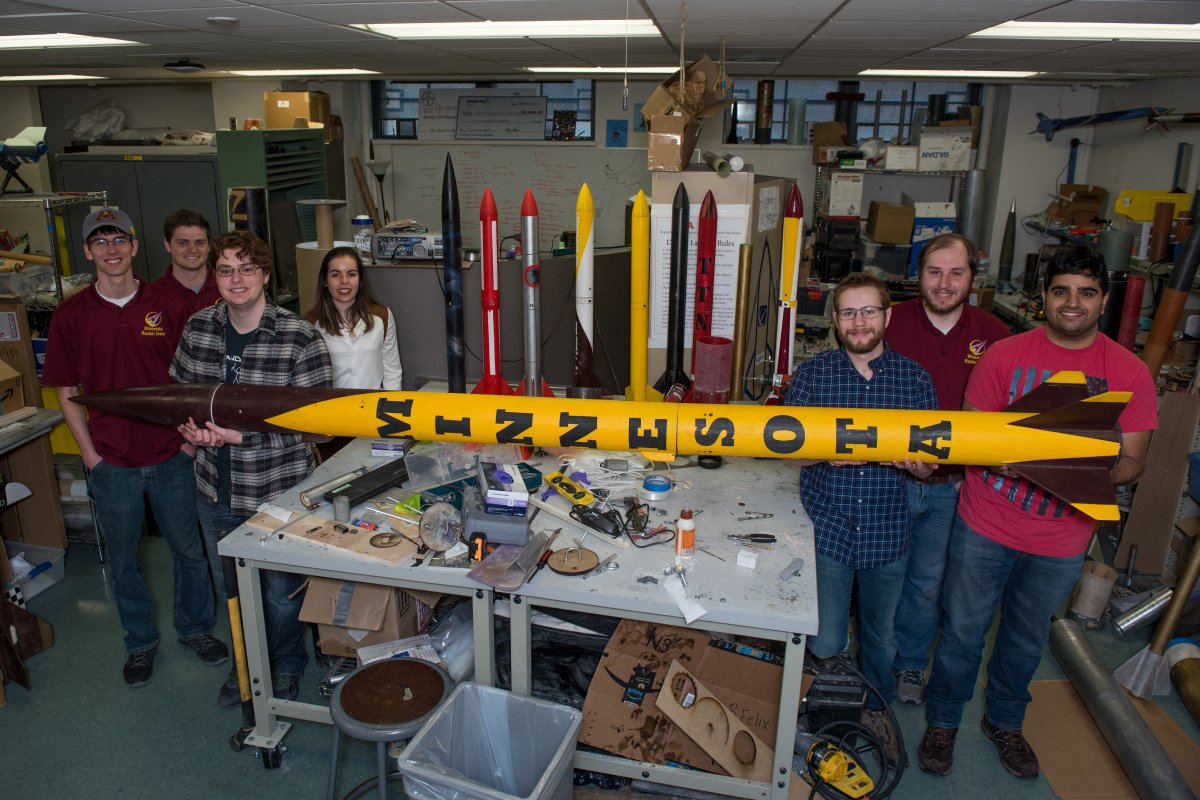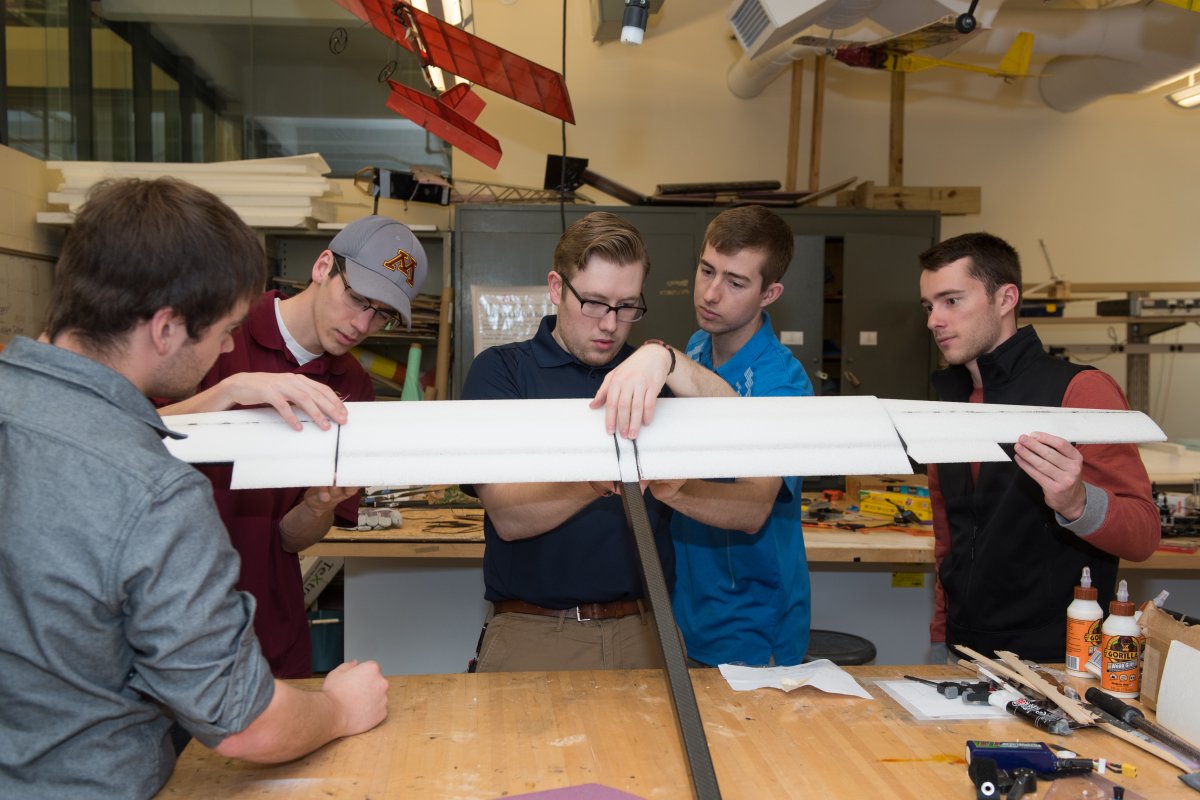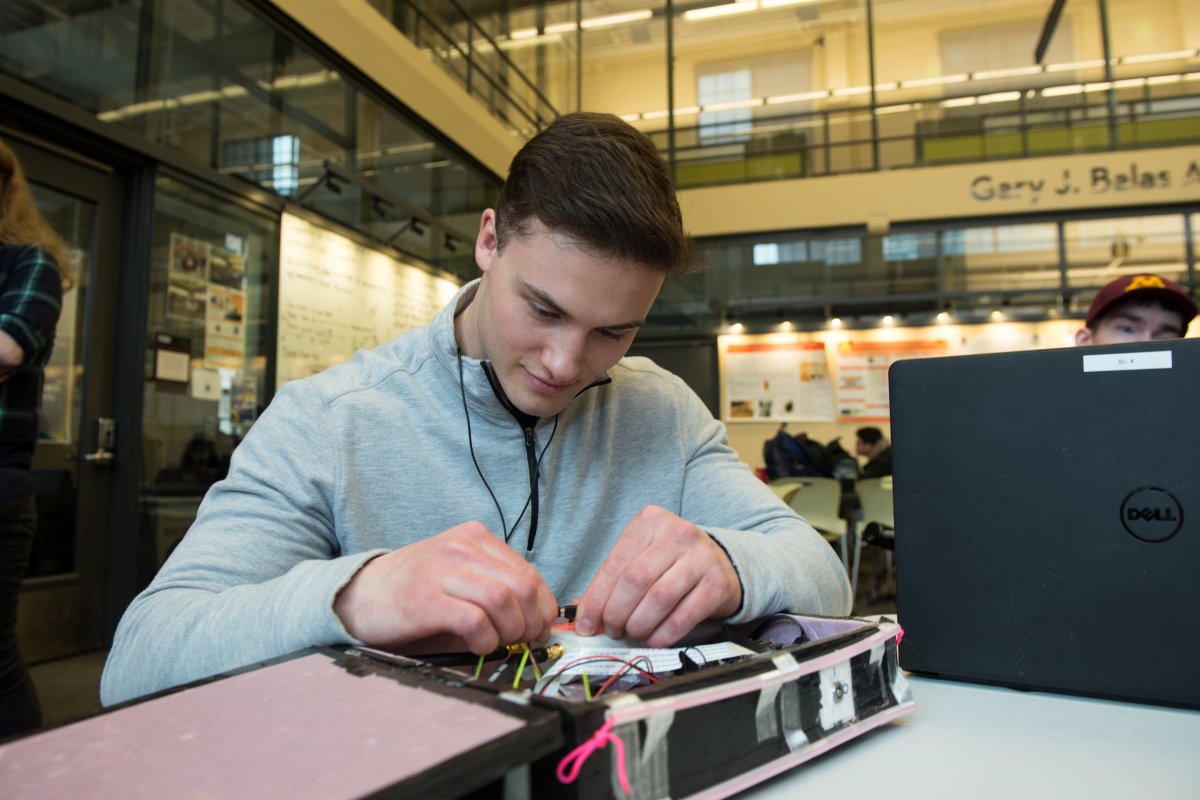Facilities










Hands-On Learning
There are many opportunities for hands-on learning in the aerospace engineering curriculum by way of AEM's research and instructional labs, as well as access to other UMN facilities.
The Department's Lab-based courses, (AEM 4601 Instrumentation Lab and AEM 4602 Aeromechanics Lab), develop practical engineering skills such as the ability to make accurate measurements and data analysis, as well as learning to use sensors and actuators in automatic control systems.
Additional facilities that the Department has to offer are state-of-the-art wind tunnels (available for coursework, student & team research), and a well-equipped brand-new maker space that includes 3-D printers and shop tools.
+
Research Facilities
Fluid Mechanics Facilities
The AEM Department is home to high-caliber research laboratories that provide a place for research and training. The facilities below are organized by discipline.
Laboratory for Turbulent & Complex Flows: These laboratories specialize in the experimental study of turbulent and multiphase flows. 30 Akerman Hall 9 Akerman Hall |
Computational Hypersonics Research Lab: The overall goal of the lab is to develop physics-based models and high-fidelity numerical methods to predict the operation of hypersonic flight vehicles and to discover new hypersonic flow physics. 230 Akerman Hall |
Computational Fluids Lab: This lab focuses on research regarding modeling complex fluid flows by developing numerical methods and algorithms to analyze complicated turbulent flows and complex gas flows. 320 Akerman Hall |
Solid Mechanics & Materials
Single Crystal Growth Facility: This lab grows large, single crystals using the Bridgman method in order to prepare buttons of metal alloys of arbitrary composition as well as growing crystals of shape memory alloys, ferromagnetic shape-memory alloys, and other alloys.
20 Akerman Hall
Phone: 612-625-8302
The Solid Mechanic and Materials Lab allows students to gain hands on experience in studying active materials. 19 Akerman Hall |
Active Materials Lab: This lab is used for the study of active materials, primarily shape memory, magnetostrictive, and multiferroic materials using multiple pieces of equipment including an in-situ Moiré microscopy, a magneto-mechanical testing machine, and more. 24 Akerman Hall |
Multiscale Mechanics & Extreme Materials Laboratory: This lab uses plate impact, laser-driven impact, and split Hopkinson pressure bar experiments with diagnostic tools such as ultra-high-speed imaging, high-speed X-ray diffraction, photonic Doppler velocimeter (PDV), and digital image correlation (DIC) to study the mechanics of materials at disparate lengths (nm-mm) and time scales (ns-µs).
|
Self Assembly and Energy Conversion Lab: This lab houses two main research projects: (1) self-assembly of objective structures and (2) ferromagnetic alloys which convert heat directly into electricity. 504 Shepherd Lab |
Aerospace Systems
The Aerospace Systems labs allow students to design and create aircraft pieces that relate to the guidance, navigation, and control algorithms.
The Guidance and Navigation Aerosystems Laboratory: This lab focuses on the guidance, navigation, and control algorithms within applications to unmanned aerial vehicles (UAVs), cubesats, and wind turbines using software technologies created in collaboration with the University of Minnesota, UC-Berkeley, and Caltech. 309 Akerman Hall |
Avionics Laboratory: This lab primarily centers around researching, designing, and developing algorithms and systems for navigation and guidance of vehicles. 404 Akerman Hall |
The UAV Laboratory: This lab has the goal to support research activities within the department including control, navigation and guidance algorithms, embedded fault detection methods, and system identification tools. 19 Akerman Hall 305 Akerman Hall |
Small Satellite Laboratory (Clean Room): These three labs allow faculty and students from various departments at the University of Minnesota to work on building two small satellites with the assistance of NASA and the U.S. Airforce. 502 Shepherd Lab |
Small Satellite Laboratory: These three labs allow faculty and students from various departments at the University of Minnesota to work on building two small satellites with the assistance of NASA and the U.S. Airforce. 508 Shepherd Lab |
Small Satellite Laboratory (#2): These three labs allow faculty and students from various departments at the University of Minnesota to work on building two small satellites with the assistance of NASA and the U.S. Airforce. 512/514 Shepherd Lab |
Aerospace, Robotics, Dynamics, and Control Laboratory: This lab develops and tests novel dynamic modeling and control theory with applications to unmanned aerial vehicles, spacecraft, and robotic systems. 130C Akerman Hall |
Position, Navigation and Timing (PNT) Lab: This lab has the goal of studying algorithms to use Global Navigation Satellite System (GNSS) signals and signals of opportunity (SoOp) for position, navigation and timing (PNT) applications in challenging environments. 552 Shepherd Labs |
+
Instructional Facilities
Additional AEM facilities provide a space for students and faculty to collaborate on student projects, research, and instruction. These labs allow students to participate in research as undergraduates, as well as conduct research as graduate students.
Wind Tunnel Lab: This lab houses the two Departmental low speed wind tunnels. Both of these tunnels operate at maximum speed of about 30 meters/second and have large cross-section test sections. One is open return and the other is closed return. 430 Akerman Hall |
Undergraduate ATK Aerospace & Design Lab: This lab is a space designed to accommodate the needs of a group of design teams. The design lab gives undergraduate students an opportunity to get their hands dirty and construct prototypes and proof-of-concept models. 130B Akerman Hall |
Aeromechanics Lab: This lab serves to give students an understanding of experimental methods and design in fluid and solid mechanics. Students learn wind tunnel and water channel experiments involving flow visualization, pressure, velocity, and force measurements. 25 Akerman Hall |
Instrumentation Laboratory: This lab is meant to give students a fundamental understanding of the measurement of a physical quantity using sensors, instrumentation amplifiers, and analog to digital converter which then interface with computers to record results. 3 Akerman Hall |
Freshman Seminar Build Activities Student Project Room: Freshman students are given the opportunity to explore Aerospace Engineering and Mechanics as a major. The seminar classes give first-year students exposure to work in a small class environment. The freshmen seminar is conducted during fall and spring semesters. Students participate in flight testing field trips and course projects can range from stratospheric ballooning, model aircraft design flight, or high powered rocketry. 394 Shepherd Labs |
Richard and Shirley DeLeo Undergraduate Student Lounge: serves as a resource and work space. The room allows AEM undergraduates and other University students with interests in aeronautics and astronautics a place to gather and participate in community-building activities such as student engineering projects and event planning (for outreach events, laboratory tours, etc). 130D Akerman Hall |
MN Space Grant Stratospheric Ballooning & High Power Rocketry Build: The Minnesota Space Grant Consortium (MnSGC) is part of the NASA Funded National Space Grant College and Fellowship Program established by Congress in 1988. Nationally, Space Grant is a network of 52 university-based statewide consortia (all 50 states, the District of Columbia, and Puerto Rico) with nearly 1000 affiliates. 398 Shepherd Labs |
+
Supporting University Facilities
Faculty and students have access to additional University facilities for the purpose of research, student projects, and more. Many of these facilities are located on campus and are accessible to all CSE students during their open hours.
Anderson Student Innovation Labs: These three labs grant students access to over 20 3D printers, 4 laser cutters, an electronic assembly area, a 3D scanner for digitizing objects, a materials testing load frame, welding facilities, and a comprehensive collection of woodworking tools. Mechanical & Civil Engineering Buildings |
Minnesota Supercomputing Institute: This lab provides access to High Performance Computing (HPC), storage, and visualization resources. MSI offers supercomputers and labs with a wide selection of software, application and database solutions, web and database hosting, and consulting 117 Pleasant St SE |
CSE Shop: The University of Minnesota CSE shop provides a wide array of machine shop services for research, including fabrication, machining, welding, on-site inspection, and consulting. 161 Mechanical Engineering Building |
Mechanical Engineering Student Shop: The Mechanical Engineering Student Shop is available for approved students from Aerospace Engineering to assist on projects. 176 Mechanical Engineering Building |
Characterization Facility: This lab is a multi-user, shared instrumentation facility for materials research. Analytical capabilities include microscopy via electron beams, force probes and visible light, including cryogenic methods; elemental and chemical imaging including depth profiling; elemental, chemical and mass spectrometry; atomic and molecular structure analysis via X-ray, ion, or electron scattering; nanomechanical and nanotribological probes; and other tools for surface and thin-film metrology. 12 Shepherds Labs |
Institute for Rock Magnetism: This lab was established as a national multi-user facility to provide state-of-the-art facilities and technical expertise to the greater geomagnetic community. Equipment includes various magnetometers, a magnetic properties measurement system, Mossbauer spectrometers, and magnetizers/demagnetizers. Institute for Rock Magnetism |
St. Anthony Falls Laboratory: The St. Anthony Falls Laboratory is an interdisciplinary fluids research and educational facility that is focused on the intersection of fluid dynamics with major societal challenges in energy, environment and health. 2 Third Avenue Southeast, Minneapolis |
Balas Atrium: This is a student study area for AEM Students to work on homework, collaborate on group projects, and socialize. This area also supports AEM student activities, and is the center for many of AEM's events. 130 Akerman Hall |